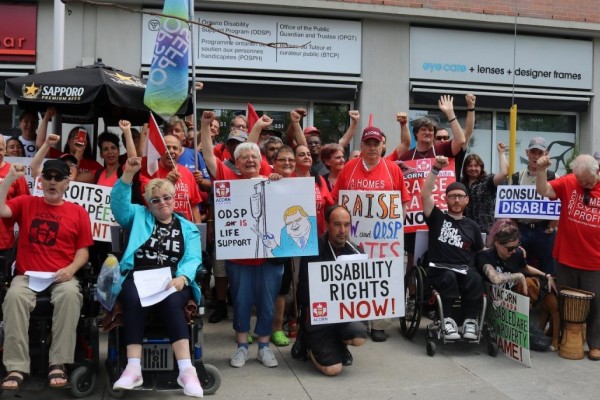Fighting for housing in Toronto’s Downtown East
The community is gearing up for an epic battle against Canada’s leading private equity real estate investment firm

The Regent Park neighbourhood in Toronto, built in the late-1940s as a public housing project managed by Toronto Community Housing. Photo courtesy the Lieutenant Governor of Ontario/Flickr.
Seven empty lots that could be used to create desperately needed housing in a poor community have been left sitting empty in Toronto’s Downtown East. For years, anti-poverty activists and community members have been demanding that the city expropriate the vacant lots at 214-230 Sherbourne Street and build affordable housing on them.
Now, the community is preparing for an epic battle with KingSett Capital, after the company announced plans to build a 47-storey condominium at the site, located in the heart of one of Toronto’s oldest working class neighbourhoods. A fight that has now spanned a decade entered a critical phase in March of 2022, when the city’s proposal for the purchase of the properties was rejected by the owners in favour of KingSett Capital’s bid.
This Bay Street investment company, which has offices in Toronto, Montréal and Vancouver, is listed as “Canada’s leading private equity real estate investment firm.” In 2016 KingSett boasted $15.4 billion dollars in equity.
In the fall of 2013, the Ontario Coalition Against Poverty (OCAP), working with social agencies, residents and the homeless, began a campaign calling on the city to expropriate 214-230 Sherbourne to build much needed affordable housing. The three rooming houses on the property had housed hundreds of poor and homeless people for more than four decades. They were boarded up in 2008, two of them were subsequently torn down, and the lots have remained empty ever since.
The third building, Dineen House, was saved from demolition due to its heritage status. The old Victorian mansion operated as a rooming house as far back as 1911, and at the start of the First World War it was housing young men who had enlisted to go fight in Europe.
Community action
Five years after OCAP’s campaign began, the property was listed for sale by the owner, who refused to sell the property to the city. A motion tabled by Councillor Kristyn Wong-Tam in March of 2018 called on the city to expropriate the properties. While the city was considering this, OCAP, working with Open Architecture Collaborative Toronto, held a consultation with members of the community and later submitted a proposal at city council for an 18-storey tower that would create hundreds of units of affordable housing.
In the fall of 2019, 27 social agencies signed a letter calling on the city to expropriate the abandoned properties. Things remained at a stand still for the next three years, with the city refusing to expropriate and the landlord refusing to negotiate the purchase of the properties.
In March 2022, the landlord hired Collier International, an investment management company, and put the properties up for sale. The market value of the lots was estimated to be between $40 million and $50 million. On March 15, the city announced that it was submitting a letter of intent, but we were later informed that they were outbid by KingSett.
It is important to note that KingSett Capital has had an ongoing relationship with the city and Mayor John Tory. On October 19, 2021, Create TO, a city agency, announced that it was partnering with KingSett and Greenwin to develop 705 Warden Avenue—one of 17 sites owned by the city to be developed for social housing. Although the new site will include 575 units, fewer than half will be designated “affordable.”
The sale of a building at 877 Yonge Street in the summer of 2019, which was purchased by the city a year and a half later, remains mysterious and controversial, with KingSett at the centre of the affair. The building was operated by Davehill Senior Living, a non-profit organization. On July 3, the 150 senior residents living in the residence were informed that they faced eviction by the end of the year. At this time, the property was listed as being owned by a numbered company, 2692518 Ontario Inc., which had been formed only days earlier by KingSett. Andrew Jeanrie, spokesperson for this company, also named KingSett as a client.
According to several media reports, Jeanrie and KingSett’s representatives refused to comment on the situation. In April 2021, the building was sold to the city, which intended to use it as affordable housing. According to one newspaper, the city paid $94.6 million—four times the market value of the property—and it is likely that it was purchased from KingSett.
The company clearly has strong and important ties with the city yet it put in a counter bid for a property that the city supposedly had a strong interest in acquiring. This raises serious concerns about the good faith of city hall in this matter and suspicion that the condominium development might well have been the outcome both parties favoured.
Privately owned lands at 214-230 Sherbourne sat vacant for a decade, while homelessness grew. In 2018, Council asked staff to approach owners to sell. Owners repeatedly said no, as they waited for a condo developer. Site is finally on the market & offers are accepted on Friday. pic.twitter.com/8ITFocE5mg
— Kristyn Wong-Tam (@kristynwongtam) March 7, 2022
Upscale redevelopment
Since 2005, when the revitalization of Canada’s largest social housing project, Regent Park, began, including the construction of luxury housing on a huge scale, land prices in and around the new development have skyrocketed. Plans are now in the works to redevelop George Street along similar lines, which would include the removal of Seaton House, Canada’s largest men’s hostel.
These two city revitalization projects have opened up the whole Dundas East corridor, from Yonge Street to River Street, to developers seeking to speculate and buy up properties in the Downtown East, thereby endangering a whole infrastructure of services in the area that took decades to establish.
The threatened social infrastructure includes services for poor and homeless people, such as community health centres, supervised consumption sites, day shelters, hostels, legal clinics, and a soup kitchen. Across from 214-230 Sherbourne is the All Saints’ Church, which has been offering services to Toronto’s most impoverished residents for more than half a century. Seaton House, and the Salvation Army’s Maxwell Meighen’s shelter, which together at their peak sheltered more than a thousand men a night, are both just a few blocks from the contested property.
If it moves forward, the development proposed by KingSett will threaten this entire infrastructure and displace more of the working poor and the homeless from the Downtown East. Toronto is in the middle of a growing housing crisis that has been decades in the making. Nowhere is this more visible than in the Downtown East.
Large encampments of homeless people were set up over the last two years during COVID. Last year Moss Park, located a few blocks south of the proposed condo project, saw the emergence of one of the largest encampments in Toronto. Today, some 25 tents have been erected in Allan Gardens, a block away from the empty boarded-up Dineen house.
The owners of 214-230 Sherbourne benefited greatly over the years from the poor who paid exorbitant rents for single rooms with shared washrooms. They were allowed to speculate on the empty lots for 14 years in the middle of the housing crisis. The city could have and should have intervened by expropriating the property years ago.
The Downtown East has always welcomed the working poor, the unemployed, and the homeless, and it has a history of resistance dating back to the 1880s. In the early 1970s, a fight to save rooming houses from gentrification led to the city buying up a huge number of rooming houses in the area.
In the mid-1980s, the death of Drina Joubert, a homeless woman who froze to death in an abandoned truck behind 230 Sherbourne, led to the formation of the Housing not Hostel Coalition. There was no subsidized housing for single adults at the time and the Coalition eventually won the right for single adults to get subsidized housing; 3,000 units of affordable housing for single adults were subsequently built; 61 of these people are living at a housing unit provided by All Saints Church at the corner of Dundas and Sherbourne.
Recently a small group of people have come together to form the 230 Fight Back Campaign. Their goal is to stop KingSett. The proposed condo tower does absolutely nothing to address the problems that poor people experience everyday, nor is it a solution to the housing needs of those who live in the Downtown East. The city needs either to expropriate 214-230 Sherbourne or begin to negotiate the purchase of the properties with KingSett.
Admittedly, this is a formidable David and Goliath battle. Those waging it do not have billions of dollars in assets but plan to create a resistance in the Downtown East which the city and KingSett will not be able to ignore. They will refuse to be pushed out. Building on the long and proud history of resistance of this working class neighbourhood, 230 Fight Back will take up this struggle with every intention of winning it.
Gaétan Héroux is a long time anti-poverty activist with the Ontario Coalition Against Poverty (OCAP).
John Clarke is a writer and retired organizer for the Ontario Coalition Against Poverty (OCAP). Follow his tweets at @JohnOCAP and blog at johnclarkeblog.com.










